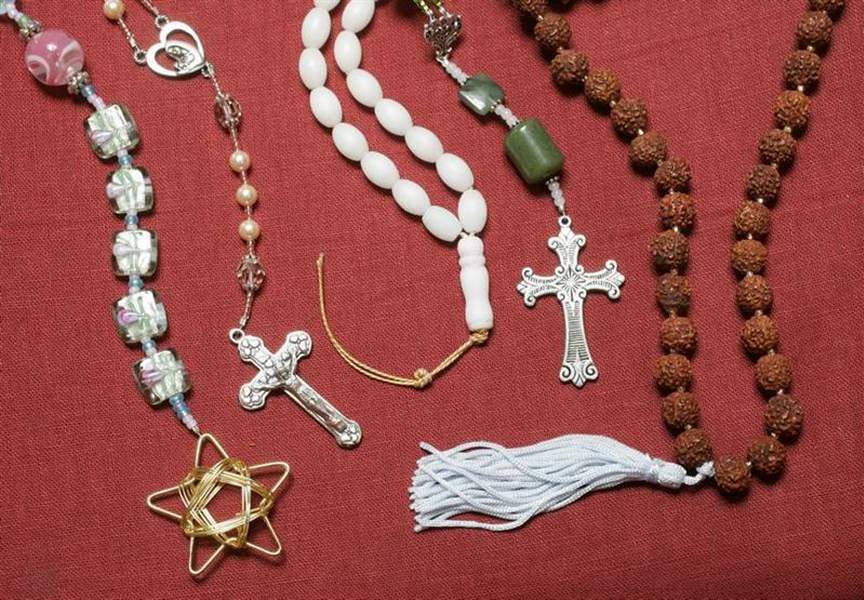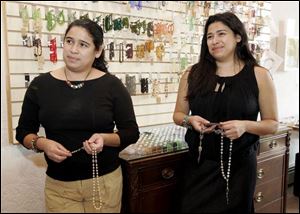
Toledo sisters' circles of prayer
5/10/2008
Baha'i prayer beads, left, a Catholic rosary, a Muslim mesbaha, Anglican Protestant beads, and a Hindu mala at the boutique.

Twin sisters Anita Tristan, left, and Ann Tristan feature religious beads at their Bonita Bead Boutique in Maumee.
Beading can be a hobby and a creative outlet, or it can be a tool for prayer and meditation. For two Toledo sisters who lost their mother in a tragic accident, beading offers a step toward healing.
"We lost our Mom about six months ago and we were looking for ways to heal," said Anita Tristan, co-owner with her twin sister, Ann Tristan, of Bonita Bead Boutique in downtown Maumee.
"We've promoted a lot of special events like breast cancer awareness and Bread for Life, and we make spiritual jewelry. Then we got an e-mail about Kimberly Winston's book and we thought it would be a good fit, that it would help us heal."
The sisters' mother, Elida Barrera, was 53 years old when she stepped out of a vehicle in November and was struck by a pickup truck.
Ann Tristan carries her mother's tiny rosary, a small set of wooden beads, in her purse, and Anita keeps a rosary in her vehicle.
The 36-year-old twins have been beading for 17 years, since they were students at Woodward High School and strung together sets of plastic beads and rhinestones for a school fund-raiser.
They took up the hobby in earnest and began making beaded jewelry, displaying their creations at trunk shows and specialty stores.
In June, 2005, the Tristans opened their quaint and colorful shop on Conant Street.

Baha'i prayer beads, left, a Catholic rosary, a Muslim mesbaha, Anglican Protestant beads, and a Hindu mala at the boutique.
"Beading is therapeutic," Anita said. "We've seen it help cancer patients keep positive attitudes and release their frustrations."
Prayer beads are used to help people count their prayers, fingering the beads as they recite petitions to God. The most popular prayer beads sold at the Maumee shop are Catholic rosaries, the Tristans said.
"People buy them and then take them across the street to get them blessed" at St. Joseph's Catholic Church, Ann said.
The next biggest sellers, by far Ann said, are Buddhist malas - long strings of 108 or 111 beads usually made with large round seeds and tied at the ends with thread using intricate Chinese knots.
Robert Kasprzak, of Monroe, has two malas that he uses to count off Buddhist mantras, one with 108 beads and one with 111.
"In the Buddhist community, everybody has malas. It's pretty standard. It's comparable to the rosary in Catholicism," Mr. Kasprzak said. "Every time you say a mantra, you click the beads."
He used a wooden mala to count off 100,000 mantras at a special retreat, he said, and has heard of some Tibetan monks using malas to count off a million mantras.
"They're really short mantras," he added.
The book that inspired the Tristans to feature prayer beads at their shop is Bead One, Pray Too: A Guide to Making and Using Prayer Beads, published last month by Morehouse Publishing.
Mrs. Winston, the California author, journalist, and beading expert, said every world religion has a tradition of counted prayer, and almost all of them have used prayer beads.
Two exceptions, she said in an interview, are Jews, who consider beads a form of idolatry, and most fundamentalist Christians - "although I have heard of at least two Southern Baptists who use prayer beads."
She said Anglican or Protestant rosaries are a fairly new concept created by an Episcopal priest in Dallas, the Rev. Lynn Bauman, in the mid-1980s.
"He had a prayer group and they were in the process of exploring different prayer traditions of the world, and when he got to the Catholic rosary, he thought he wanted something more Anglican," Mrs. Winston said.
"It felt funny to him to tamper with the Catholic rosary - like it would be disrespecting that faith - so he started sketching and came up with the Anglican rosary."
Catholic rosaries are divided into decades, or groups of 10 beads, and can range from a single decade to 15 decades in length, with a crucifix at the end. Some also have a small medallion of the Virgin Mary.
Anglican rosaries have 33 beads, one for each year of Jesus' life, and four "cruciform beads" that make up the four points of the cross, Mrs. Winston said.
One of the joys of the hobby is that anyone can make prayer beads, she added.
"All you have to be able to do is thread a needle and tie a knot. You can make yourself a set of prayer beads out of anything. They may not last for 20 years but that's one of the beauties of beads: You're not going to break the beads, just the string. All you have to do is rethread them."
The Tristans said it can cost as little as $10 or $15 to make prayer beads, depending on materials. Pewter crosses are cheaper than sterling silver, for example. And plastic beads are less expensive than glass.
The most popular material at their store is Czech glass, which comes in a vast array of colors.
And when it comes to making prayer beads, there are no rules or restrictions.
"We always tell people to pick colors that are in their personality," Ann Tristan said.
The prayer beads made by Mrs. Winston that are on display at Bonita Bead Boutique range in price from $45 to $85 and are made from materials such as Czech glass, alabaster, amethyst, Japanese seeds, and mother of pearl.
The religious symbols used for the sets include a Celtic cross for Anglicans, a star for Baha'is, a crucifix for Catholics, and a tree pendant.
Mrs. Winston said that in her research she discovered that prayer beads go beyond mainstream religious boundaries. There are pagan and neo-pagan, wiccan, and astrological prayer beads, and even birthing prayer beads for pregnant women and death prayer beads for people who want to meditate on the mysteries of darkness and destruction.
Shelly Schaeffer, music director at Washington Church on Central Avenue, was looking through Mrs. Winston's trunk display at the Maumee shop and picked up a copy of Bead One, Pray Too.
"This is just really great, and it's a great way to promote diversity and understanding," Ms. Schaeffer said.
She said she couldn't wait to show the book to her daughter, whose best friend is a Muslim, because of the section on Muslim mesbahas.
Mrs. Winston said one of the great things about prayer beads is that they bring diverse people together.
"What always excites me is how we are all the same, not how we are different," she said.
The "Bead One, Pray Too" prayer beads trunk show will be on display through the end of May at Bonita Bead Boutique, 215 Conant St., Maumee. More information is available by calling the store, 419-887-4000 or online at www.bonitabeadboutique.com.
Contact David Yonke at:
dyonke@theblade.com
or 419-724-6154.